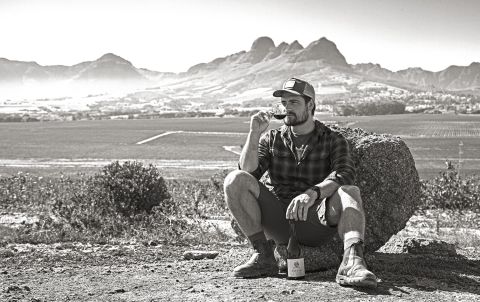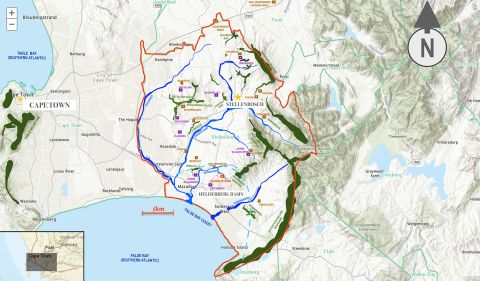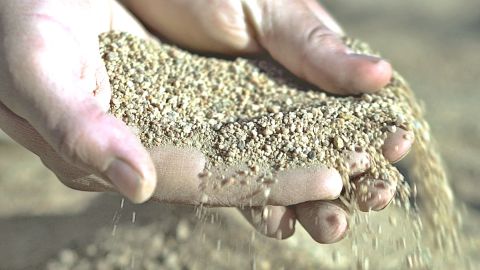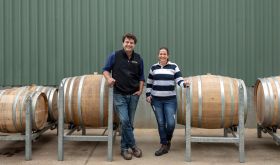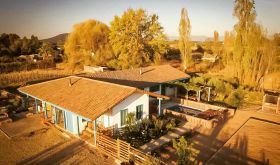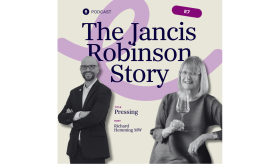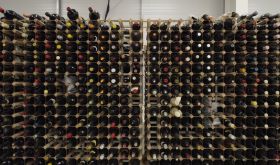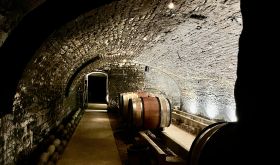I’ve had the deep, dark mocha-flavoured Pinotages, the smoky, gamey, wildly ripe ones, even the lighter, juicy blue-fruited ones. But before last week, I had not had, despite ample assurance that they existed, a Pinotage that provided the ethereal mossy, mulchy earthiness of Pinot Noir and combined it with delicate sweet cherry fruit. This wine managed to feel sprightly despite its concentrated flavour and the tannins were beautifully supple. While the acidity wasn’t particularly notable, the wine kept a light, lithe freshness all the way through the finish – where a lick of smoky gaminess and a wild spice denoted that it was not, in fact, Pinot Noir. With chilli-laced East African-style fish stew and yellow rice the wine sang; with crispy carnitas and posole it thrummed a merry cherry tune. Intrigued, I began researching the man and vines that created it.
Bernhard Bredell is the seventh generation to farm vines and make wine on Sinai Hill – a granite outcrop that begins 3.5 km (2.2 miles) from False Bay in the lower Helderberg in Stellenbosch, South Africa.
For many years his family owned nearly 200 ha (494 acres) in this area where they grew grapes and made wine for KWV, then a powerful co-operative. At a time when ‘Cape port’ was growing in popularity, Bredell’s grandfather and great-uncle, Koos and Piet Bredell, made headlines across South Africa for the quality of the port they grew and vinified. Bredell’s father, Anton, launched the family’s own label with the 1991 vintage, claiming the first wine awarded five stars by Winemag and five stars in Platter’s Wine Guide. Still, 80% of what the family sold went to KWV and in 2005, when KWV pumped the brakes, Bredell remembers hearing, ‘port is dead in the water for consumer markets’. Within two years KWV was buying next to nothing.
For a few years Bredell’s father attempted to process all the fruit and sell it through their own label, but the market was gone. In 2010, when Bredell’s grandfather passed away, his father sold the first parcel of property and suggested Bredell pursue a degree in engineering. The remainder of the property was sold off until, in 2013, there was nothing left.
Bredell, armed with a degree in winemaking but no land or winery, went to work making wine at Radford Dale. Driving to work each day, he watched his family’s old bush vines being uprooted. Then in 2017, unable to watch any longer, spurned onwards by a desire to salvage what was left, he started Scions of Sinai and began approaching the new property owners. Slowly, working in collaboration with farm owners, he took over the farming direction of 17 ha (42 acres) of vineyards, prioritising old dry-farmed vines, eliminating herbicides and cultivating cover crops in the winter months. His cousin, Pieter Bredell, whose branch of the family had sold bulk to whoever would buy, had managed to keep 95 ha of the original family property – Rustenhof – of which Bredell helps to farm about 10 ha (25 acres) of the oldest vines. Bredell buys what he can from what he farms (about 8 ha/20 acres of old-vine fruit) and finds small-production wineries to buy the remainder.
The Pinotage I tasted, called Féniks, is made from dry-farmed bush vines that were planted by Bredell’s grandfather and grand-uncle in 1976. When Bredell contacted the grower who currently owns the property, he found out that the parcel was slated to be uprooted. Bredell persuaded the grower to allow him to work the vines and buy the fruit instead. He named the wine ‘Féniks’, Afrikaans for Phoenix, to honour the birth of a wine from what was nearly ashes. The name also honours the rebirth of Pinotage from a bad reputation (the late Michael Broadbent MW used the term ‘burnt rubber’ to describe the aroma of Pinotage back before the turn of the century).
As Malu Lambert covered in her 2023 South Africa vintage report, Stellenbosch’s 2023 vintage was fairly warm and dry in the winter with a moderate spring and early summer. In December, prior to veraison, the region received welcome rain. This invigorated the old, dry-farmed vines that made Féniks and the fruit was harvested on 1 February.
I asked Bredell over email about his winemaking, and he replied, ‘We have our own technique that works for us. It’s very primitive, logical and I think Old World common sense.’
After hand-picking, 70% of the Pinotage for Féniks is destemmed. Then 30% whole-cluster fruit is layered on top of the destemmed fruit in a 1,500-litre open-top vessel. This layering, which Bredell calls the ‘lasagne method’, naturally keeps most of the destemmed berries submerged during their 10- to 12-day fermentation.
Bredell mentions that for most wineries this would be an impossibility as Pinotage has such high yeast assimilable nitrogen levels (YAN, a yeast nutrient) that ferments tend to be aggressive, rough and fast. Féniks, grown on nutrient-poor granite soils, has lower YAN, relatively speaking, allowing for gentle, smooth ferments at 22–26 °C (72–79 °F) that require only a handful of pumpovers. For the most part, extraction relies on a gentle ‘infusion’, leading to the medium ruby colour and supple tannin structure. Once the wine is pressed it is aged in neutral 400-litre and 225-litre French oak barrels for 12 months.
Listed by Wine-Searcher at $39.99, £34.75 (AG Wines and imported by Indigo Wines), HK$350 (TenCellars) and 405 rand (Caroline’s Fine Wine Cellar) this wine is by no means inexpensive. However, I consider it to be incredibly good value.
A note on the importer/retailer for US drinkers
Scions of Sinai is imported into the US by Culture Wine Co, founded by Peter Andrews at the end of 2023. Determined not to allow the US’s archaic three-tier system get in the way of bringing more South African wine to the widest audience possible in the States, he also set up as a wholesaler and as an e-commerce retailer. As he points out on his site, ‘South African wine accounts for less than 1% of all US imports today’.
As very few US consumers randomly jump online to buy South African wines, he hosts many events (he has eight events in California between 29 April and 7 May, all of which include Bernhard Bredell of Scions of Sinai, and one which includes our Alder Yarrow).
Of the six samples Andrews sent me (from Scions of Sinai as well as Luddite and Brookdale), all were over-performers. My grandmother, who eschews white wine, could not get enough of Luddite’s Saluez le Saboteur white blend from Bot River (widely available in the UK).
You can explore South Africa's wine country on our site through the entries in The Oxford Companion to Wine, the maps in The World Atlas of Wine and of course our robust tasting notes database.


